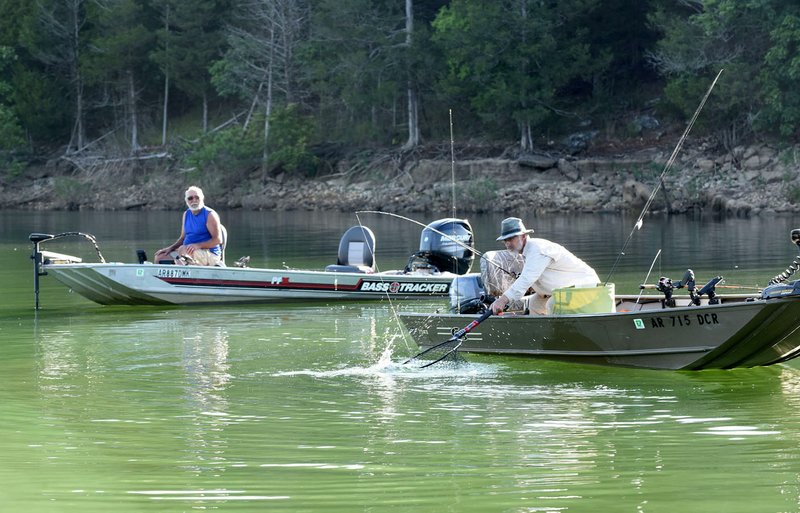A fishing lure does its work in the water, not dangling in mid air from a rod tip between casts.
That's one reason why legions of anglers are fond of trolling, especially during summer.
Know the limits
Trolling routinely results in a mixed catch. Here are length limits and daily limits at Beaver Lake for game fish:
• Crappie must be 10 inches or longer to keep. Daily limit 15.
• Walleye must be 18 inches or longer to keep. Daily limit four.
• Striped bass must be 20 inches or longer to keep. Daily limit three.
• White bass has no length limit nor daily limit.
Source: Staff report
With trolling, there's little casting involved. Give the lure one heave so it splashes down behind the boat, let out a little more line and drag the lure along as the boat moves slowly forward.
The lure is always swimming down deep, wiggling an enticing dance to tempt walleye, catfish or crappie. No telling what's going to bite a lure that's always in the water while a fishermen covers lots of water by trolling.
A mixed catch might include big white bass, like the ones that Bruce Darr welcomed into his boat, trolling as the sun came up on the Fourth of July. Trolling lit a fuse under white bass and hybrid stripers in a creek arm at Beaver Lake.
Big creek arms like Pine Creek, Joe's Creek, Esculapia Hollow and Ford's Creek are hot spots for trolling. Darr trolled in a smaller creek arm that most trollers would overlook.
"The white bass are here. Last week the hybrids were just thick in here," Darr said.
Hybrid stripers up to 10 pounds pounced the minnow-looking crank bait he trolled behind his boat.
Darr is an ardent fly fisherman, but opted for a spinning rod this Independence Day.
"I've been having so much fun trolling I've never got out the fly rod," he said.
Word was out that the little creek arm was hot. Five boats, including Darr's, plied the 85-degree water, trolling all the way. White bass and hybrid stripers opened the fishing fireworks. Slab-sized crappie followed, all between 11 and 14 inches.
Crappie are what scores of devoted trollers hope to catch at Beaver Lake when dragging crank baits during summer.
Mitch Glenn of Garfield owns Pico Lures and churns out hundreds of crank baits at his shop near the lake. Trolling has been so good this summer he has trouble keeping shelves stocked at area tackle stores.
"Three weeks ago, you could barely get a rod in the water before you'd catch a crappie," Glenn said. "It's slowed down now, but people are still catching them."
Glenn recommends bright colors for summertime trolling with crank baits. Use a lure that runs 10 to 20 feet deep. The thinner the line, the deeper a trolled lure will run. Ten-pound test monofilament line or thinner is good.
"I like to use 20-pound-test braided line because it has the same diameter as 6-pound test mono," Glenn said.
That way, if he hooks a big striper or catfish the line is strong enough that a hard fighting fish won't break it.
Right now, crappie are suspending just above the thermocline, which is 20-25 feet deep, Glenn said. The thermocline is where the warm top layer of water meets the cold bottom layer when the lake stratifies once the water warms up.
Finding schools of threadfin shad is key. Crappie, white bass and all game fish feed on shad and follow schools of shad. These bait fish can be tiny as a fingernail sliver or up to three inches long.
A depth finder is a good tool to have aboard. On the screen, shad schools will look like an underwater cloud and most units will show game fish round them. Whether those fish will bite a lure is another story.
"Ideally, you want your lure to go right through the middle of the shad school or just above it," Glenn coached. Sometimes an angler might feel little ticks, like tiny little bites. "That's your lure going through the shad. Sometimes you'll even hook one."
Trolling is a good tactic from summer and into fall.
"It ought to be good until the water temperature drops down into the 60s, around October," he said.
Plenty of opportunity to let crank baits do their underwater work.
Flip Putthoff can be reached at [email protected]
Sports on 07/24/2018

